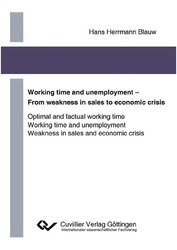| Areas | |
|---|---|
| Serie de libros (96) |
1378
|
| Nachhaltigkeit |
3
|
| Gesundheitswesen |
1
|
| Letra |
2362
|
| Medienwissenschaften | 16 |
| Teología | 57 |
| Filosofía | 102 |
| Derecho | 422 |
| Economía | 850 |
| Ciencias sociales | 416 |
| Ciencias del deporte | 48 |
| Psicología | 233 |
| Educación | 190 |
| Historia | 182 |
| Arte | 110 |
| Ciencias culturales | 165 |
| Literatur | 116 |
| Lingüística | 88 |
| Ciencias Naturales |
5406
|
| Ciencias Ingeniería |
1790
|
| General |
97
|
|
Leitlinien Unfallchirurgie
5. Auflage bestellen |
|
Erweiterte Suche
Working time and unemployment - From weakness in sales to economics crisis (Tienda española)
Optimal and factual working time Working time and unemployment Weakness in sales and economic crisis
Hans Herrmann Blauw (Autor)Previo
Indice, Datei (43 KB)
Lectura de prueba, Datei (610 KB)
It is obvious that unemployment has something to do with working time. But all the approaches to explaining unemployment have in common that they do not take into account the quantity of work per employee, as desired by suppliers and demanders, and therefore say little that is convincing about this ongoing problem. This study derives how the unemployment rate is connected with the working time. The questions are investigated theoretically and the results tested empirically using economic data for the USA, Japan and Germany from 1850 on. The optimal working time of the employee sinks when the wage rate or non-work income increase or working conditions deteriorate, and the factual working time is higher than optimal for the employee and lower than optimal for the company. The unemployment rate rises with an increasing difference of factual to optimal working time. If working time is not shortened when labour productivity increases, the unemployment rate can rise until the national income stagnates or decreases.
In a total economy, savings can become so high that not enough profitable or at least amortisable investments in newly produced goods are possible. In that case, savings are left over and production no longer flows fully into consumption and investment. If more is then invested in assets, the economic circuit can slacken off even to the extent of economic crisis. Possible measures for remedy are discussed, the most effective being that the amount of saving is reduced or invested more in real goods. The economic crisis from 2007 is compared with that from 1929 and with later recessions. Because of the higher debt today the crisis has a larger potential than that from 1929. In Western industrialised countries it is combated predominantly by government loans to the financial industry. But the economic crisis is first and foremost a sales crisis, and cannot be remedied this way. A viable way to resolve it is to skim off the surplus savings by levying higher taxes on high incomes and speculative assets, to invest or consume them via the state, and to reduce the working time per employee.
| ISBN-10 (Impresion) | 3954040808 |
| ISBN-13 (Impresion) | 9783954040803 |
| ISBN-13 (E-Book) | 9783736940802 |
| Formato | A5 |
| Idioma | Inglés |
| Numero de paginas | 132 |
| Laminacion de la cubierta | mate |
| Edicion | 3. revidierte Aufl. |
| Volumen | 0 |
| Lugar de publicacion | Göttingen |
| Fecha de publicacion | 27.04.2012 |
| Clasificacion simple | Libro de divulgacion |
| Area |
Economía
Ciencias sociales |
| Palabras claves | utility, Nutzen, wage and working time from 1850 on, Lohn und Arbeitszeit ab 1850, labour supply curve, Arbeitsangebotskurve, unemployment rate, Arbeitslosenquote, reduction in working time, Arbeitszeitverkürzung, Okun's law, Okuns Gesetz, secular stagnation, säkulare Stagnation, course of the economy, Witrtschaftsablauf, economic circuit slackens off, Wirtschaftsskreislauf stockt, saving and investment, Sparen und Investieren, excess liquidity, Überschussliquidität, Great Depression, Weltwirtschaftskrise, economic crisis from 2007, Wirtschaftskrise ab 2007, overproduction, Überproduktion underconsumption, Unterkonsumption, sales gap, Absatzlücke speculative money, spekulatives Geld, surplus, Überschuss |








